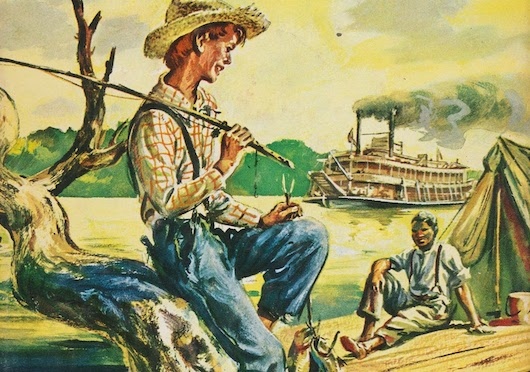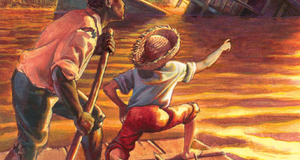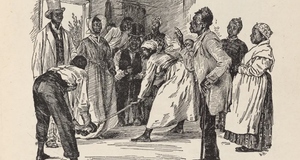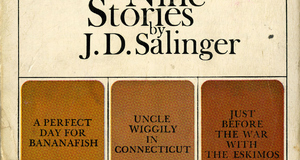Mark Twain's Portrayal of Family and Relationships in Adventures of Huckleberry Finn
By
2014, Vol. 6 No. 03 | pg. 1/2 | »
IN THIS ARTICLE
Whether real or symbolic, the family and the relationships within family units are a frequent theme in Mark Twain’s classic Adventures of Huckleberry Finn. Because there are many parallels between the characters and events within Huck Finn and the events and individuals surrounding Twain’s life, an examination of the biographical and historical context surrounding the novel’s composition reveals that Twain was influenced both socially and personally by the declining moral and social conditions of the family in the late 1800s. The events of the period induced him to indirectly voice his concerns, cautions, and beliefs through the perceived innocence of a young boy and his adventures. 
Huck Finn from the 1954 cover of the Adventures of Huckleberry Finn, illustrated by Richard M. Powers Mark Twain’s Understanding of FamilyTo more fully understand the development of Twain’s characters in Adventures of Huckleberry Finn, the author’s personal family life, his beliefs about the family, and his friends and acquaintances must be considered. Twain’s experiences with the family were generally positive. He grew up in a stable, loving environment, with parents who supported his ambitions and inspired in him a sense of morality, kindness, and justice, especially his mother, Jane Clemens. Albert Bigelow Paine, Mark Twain’s official biographer, writes that she was “an outspoken, keen-witted, charitable woman” with “a heart full of pity” (14), but had a firm hand when the occasion required it. Although Twain’s father, John Clemens, was a serious man who “seldom devoted any time to the company of his children” and “rarely laughed” (Paine 8), he was hardworking and placed great importance on caring and providing for his family. Later in Twain’s life, after marrying Olivia Langdon and having three girls, he, for the most part, enjoyed a loving, contented marriage and family life. Paine writes of Olivia Clemens that “no children had more careful training than hers, no husband more devoted attendance and companionship, no household was ever directed with a sweeter and gentler grace or with greater perfection of detail” (163). Regarding Twain’s marriage, William Dean Howells, a close friend of Twain’s, remarked, “Marriages are what the parties to them alone really know them to be, but from the outside I should say that this marriage was one of the most perfect” (qtd. in Paine 163). The relationship of Huck and Jim is the ultimate demonstration of Twain’s ideal family relationship. Although their “family” lacks the conventional roles of the father, mother, and children, it nevertheless “embodies an ideal of community that highlights the shortcomings of the actual families and society in the novel.”
Throughout his life Twain interacted with many individuals who spawned ideas for his novel and helped shape the many characters in Huck Finn. According to Walter Blair, Twain once stated, “I don’t believe an author … ever lived, who created a character. It was always drawn from his recollection of some one he had known. … [or] from the blending of two or more real characters” (270). David Fears writes that “[Twain's] boyhood days … were filled with adventures, escapades and personalities[,] many of which were to find their way into his many novels years later” (6). Parallels Between Characters in Twain’s Life and Characters in Huck FinnTwain based Huck on a childhood friend, Tom Blankenship, “a model for rebelliousness in the face of all authority” (Fears 9). Paine says of Tom, “[He] was the son of an indigent family, exactly as pictured in [Huck Finn]: a ruin of rags, a river rat—kind of heart and possessing the priceless boon of absolute freedom. He could come and go as he chose; he never had to ask for permission; he never went to school; he could sleep anywhere” (23). This description is clearly noticeable in the person of Huck, especially following his escape from Pap’s cabin in the woods. Even more analogous to Huck’s character and family is the fact that Tom Blankenship’s father was also known as “old drunken Ben Blankenship” (Paine 23), in similarity to Pap, and Fears notes that “the Blankenships were infamous drunks and ne’er-do-wells” (9). In addition, the character of Jim, Huck’s Negro friend, is indebted to a former slave of Twain’s uncle John Quarles, Uncle Dan’l, whom Twain knew in his boyhood and to whom Twain owed his strong appreciation of the black race. Regarding Emmeline Grangerford’s character, Blair writes that “Twain had [long] been fascinated and delighted with the comic possibilities of lugubrious poems about death” and after reading the obituary poems produced by many American humorists Twain “was destined to work this vein” (210). Blair suggests that the individual who most influenced the creation of Emmeline’s person was an obituary poet and singer named Julia A. Moore. Similar to Emmeline Grangerford, Moore composed “sentimental” songs and poems “inspired by her memories, her reading in books and newspapers … [and] by the deaths of neighbors” (Blair 210). Emmeline’s father, Colonel Grangerford, originated from more than one individual, including a character from one of Bret Harte’s books, Colonel Culpepper Starbottle, and Twain’s own father, John Clemens, who, like the colonel, “often wore a blue swallow-tail coat with brass buttons,” was “very tall … with a long, thin smooth-shaven face,” had a look that “could stare his family into obedience,” and “had elaborate manners” (Blair 215). Blair also records Twain reminiscing about certain personal experiences that generated the writing of the feud between the Grangerfords and Shepherdsons in Huck Finn. In his early adventures on the Mississippi River, Twain encountered a feud between the Darnell and Watson families who, like the feuding families in Huck Finn, each lived on either side of the Mississippi River. During the feud, several instances took place, all parallel to the Shepherdson/Grangerford episode, in which a man shot a twelve-year-old boy from the rival family, the men of the families attended church armed with shotguns, and one family ambushed the wagon of the other family while both were returning home from church. In the case of the two con men, the Duke and the King, who join Huck and Jim in their river journey, they bear resemblances to two men of Twain’s acquaintances: respectively, Jesse Leathers, a distant cousin of Twain’s, and Charles C. Duncan, the captain of the ship on which Twain sailed on his expedition to the Holy Land in 1867.Continued on Next Page » Suggested Reading from Inquiries Journal
Inquiries Journal provides undergraduate and graduate students around the world a platform for the wide dissemination of academic work over a range of core disciplines. Representing the work of students from hundreds of institutions around the globe, Inquiries Journal's large database of academic articles is completely free. Learn more | Blog | Submit Latest in Literature |
















